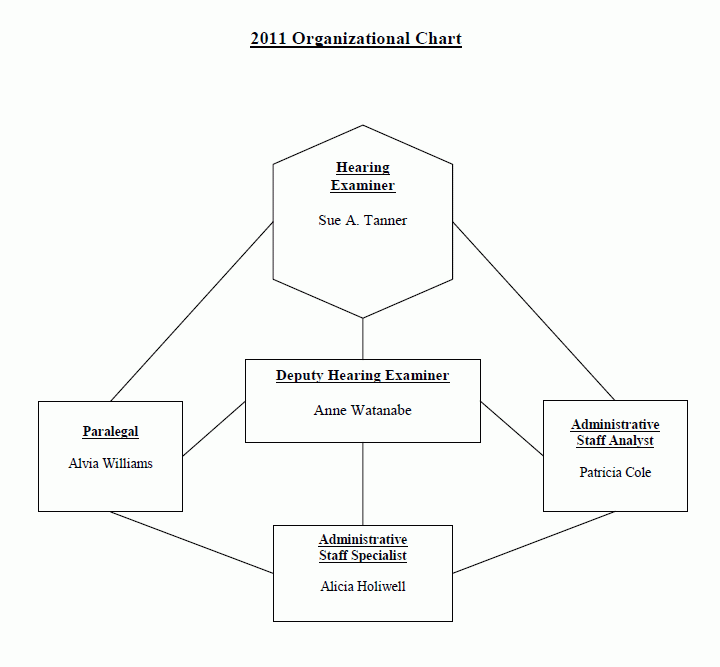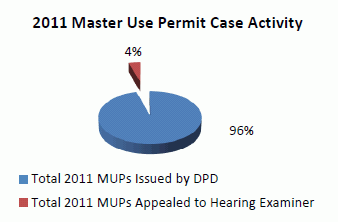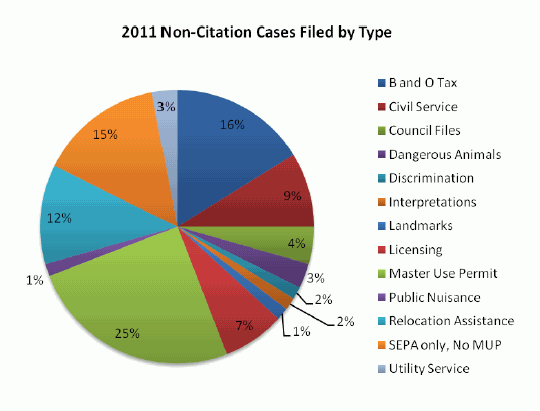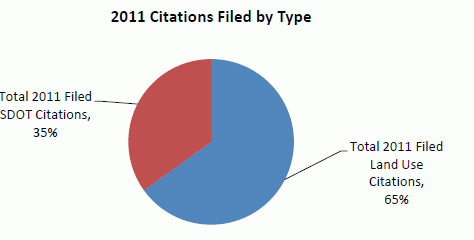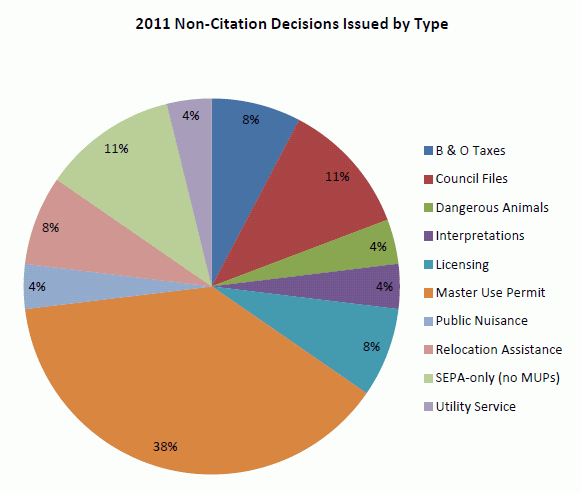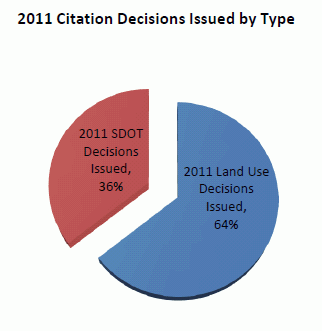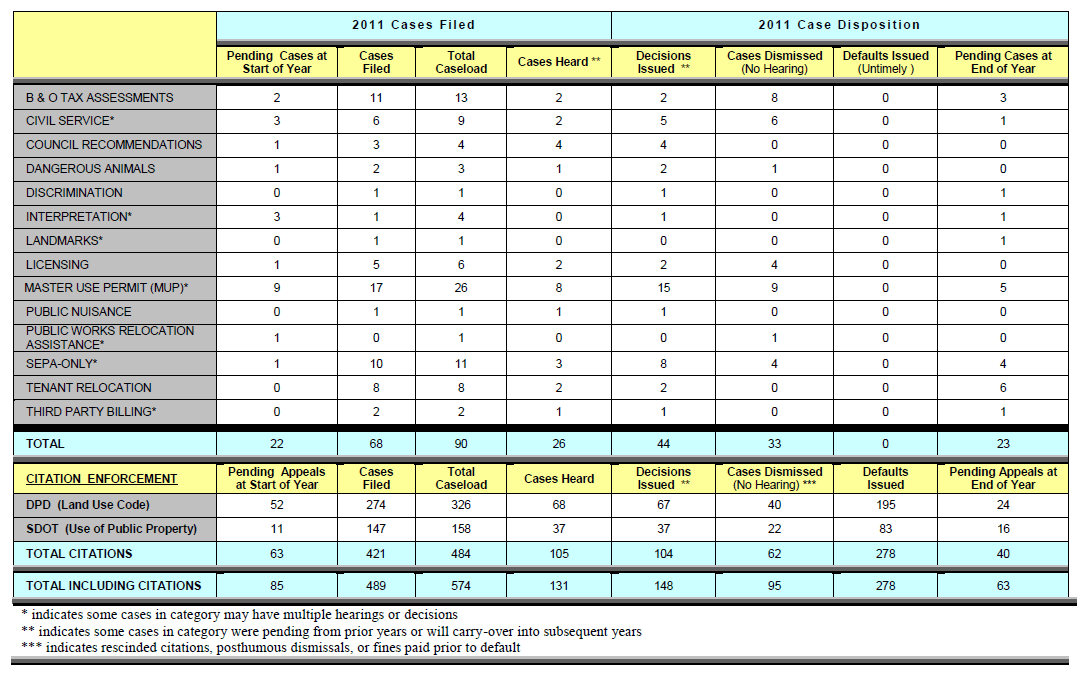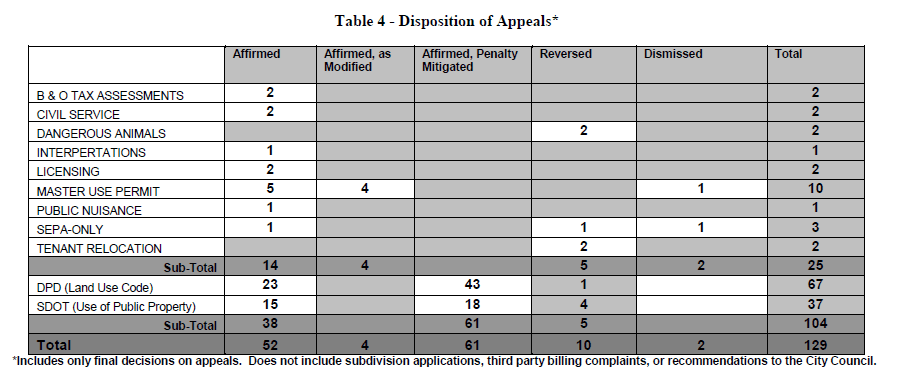Seattle Comptroller/Clerk Files Index
Information modified on April 6, 2012; retrieved on May 19, 2025 9:50 PM
Clerk File 312198
Title | |
|---|---|
| 2011 Annual Report of the Office of the Hearing Examiner. | |
Description and Background | |
|---|---|
| Current Status: | Filed |
| Index Terms: | HEARING-EXAMINER |
| Notes: | Originally referred to the Planning, Land Use, and Sustainability Committee on March 26, 2012. |
Legislative History | |
|---|---|
| Sponsor: | Conlin |
| Date Introduced: | April 2, 2012 |
| Committee Referral: | Full Council for Action |
| City Council Action Date: | April 2, 2012 |
| City Council Vote: | 8-0 (excused: Rasmussen) |
| Date Filed with Clerk: | March 14, 2012 |
| PDF Copy: | Clerk File 312198 |
Text | |
|---|---|
|
City of Seattle OFFICE OF HEARING EXAMINER 2011 ANNUAL REPORT Office of Hearing Examiner Seattle Municipal Tower, Suite 4000 700 5th Avenue Seattle, Washington 98104 Phone: 206) 684-0521 Fax: (206) 684-0536 March 2012 2011 City of Seattle CITY COUNCIL SALLY BAGSHAW TIM BURGESS SALLY CLARK, PRESIDENT RICHARD CONLIN JEAN GODDEN BRUCE HARRELL MIKE O'BRIEN NICK LICATA TOM RASMUSSEN
CITY OF SEATTLE OFFICE OF HEARING EXAMINER 2011 ANNUAL REPORT Mission and Authority The mission of the Office of Hearing Examiner is to conduct fair and impartial administrative hearings in matters where jurisdiction has been granted by the Seattle Municipal Code, and to issue clear and timely decisions and recommendations that are consistent with applicable law. The position of Hearing Examiner is established in the Seattle Municipal Code, and the Hearing Examiner is appointed by the City Council to serve an initial one-year term and subsequent four-year terms. The Hearing Examiner is responsible for all functions of the Office and is authorized to appoint Deputy Examiners and other staff. The inside front cover of this report shows the organization chart and Office staff for 2011. The Office of Hearing Examiner was created as a separate and independent City office under Chapter 3.02 of the Seattle Municipal Code. Before the Office was created in 1973, some appeals of administrative decisions were heard by the City Council; others went directly to court. Pursuant to authority conferred throughout the Code, the Office of Hearing Examiner now provides an independent hearing forum to review decisions made by many City agencies and to provide recommendations to the City Council on some land use applications. Jurisdiction The Office of Hearing Examiner currently has jurisdiction over more than 75 different types of matters.1 We track all cases that come into the Office as "Cases Filed". The most numerous of these are appeals of decisions made by other City agencies, such as the Department of Planning and Development (Master Use Permits, SEPA determinations, Code Interpretations, Land Use and Noise Enforcement Citations and decisions on tenant relocation assistance); the Department of Finance and Administrative Services (tax assessments and licensing decisions); Special Purpose District Commissions (certificates of approval for alterations); and the Department of Transportation (Citations related to right-ofway use). When the Hearing Examiner has original jurisdiction, the Examiner makes the initial decision in a case rather than reviewing another department's decision. Original jurisdiction cases include subdivision applications processed by the Department of Planning and Development; complaints filed by the City Attorney's Office for discrimination in employment, housing, public accommodation, or public contracts; complaints for third party utility billing violations; petitions for review of floating home moorage fee increases; and others. The City Council has retained jurisdiction over certain land use actions, including Council conditional uses, rezone proposals, major institution master plans, and landmark controls and incentives. For these cases, the Hearing Examiner holds a public hearing for the Council, 1 See complete list at p. 17. gathers information to establish the record, and forwards the record and a detailed written recommendation to the Council for its use in making the decision. Accessibility An administrative hearing before the Hearing Examiner is a quasi-judicial process that involves the application of existing law and policy to the specific facts of a case. Constitutionally guaranteed due process requires procedural safeguards for those whose rights are affected by the outcome of the case. The hearing format resembles an informal court proceeding and is structured to provide a fair opportunity for each party to participate, while also reflecting the seriousness of the matters appealed for those involved. The Office of Hearing Examiner uses several tools to make the hearing process understandable and "user friendly," while at the same time protecting the rights of parties and fulfilling legal requirements. Examples include: a "Public Guide," which is a booklet that explains the hearing process in a question and answer format; "fill-in-theblanks" appeal forms; an explanatory letter that is sent along with the notice of hearing in each case; and two pocket-sized pamphlets that include basic information about the hearing process and are available from the Office, neighborhood centers, and most libraries. In addition, the pamphlet on code enforcement citation hearings is included with each citation issued and if indicated, a card in one of the City's six core languages or Russian is handed out with the citation. The card explains what basic hearing-related information is available from the Office of Hearing Examiner. In 2011, we began accepting credit and debit cards for payment of filing fees and citation penalties. We provide language interpreters for appeal hearings when requested, and also solicit feedback from everyone who participates in a hearing. Our "Customer Satisfaction Survey" is available on-line, as well as in the office and hearing rooms, and may be completed anonymously. The Hearing Examiner's website, at www.seattle.gov/examiner includes the Hearing Examiner Rules, the "Public Guide," appeal forms and fee information, a schedule of upcoming hearings, the "Customer Satisfaction Survey," the most recent annual report, and information on making a request for disclosure of public records. Decisions dating back through 1990 are also available in a searchable database through a link on the website. Contracting Since 2004, the Hearing Examiner has been authorized by the Seattle Municipal Code to provide hearing examiner services to other jurisdictions via contract. We currently provide contract examiner services to five cities: Kirkland, Mercer Island, Puyallup, Shoreline and Tukwila. Our work for four of our contract cities was noticably reduced in 2009, but the the addition of the City of Puyallup late that year served to stabilize our workload in 2010. It remained stable in 2011, and the revenue generated from contract work increased 140%. We conducted 27 hearings and issued 30 decisions for our contract cities in 2011, compared with 20 hearings and 25 decisions in 2010. The revenue increase reflects the fact that several of the 2011 cases were complex and involved multiple hearing days and significant time for record review, research and preparation of a decision. In addition to bringing in a modest amount of revenue for the City's general fund, working with other cities adds variety to our case load and keeps us flexible. Judicial Appeals of Hearing Examiner Decisions At the request of the City Council, and with the assistance of the City Attorney's Office, the Office of Hearing Examiner tracks the results of judicial appeals of Hearing Examiner decisions. The following appeals were decided in 2011: In Fremont Neighborhood Council v. City of Seattle, King Cy. Superior Ct.#08-2-413241SEA, the Superior Court affirmed the Hearing Examiner's decision upholding the SEPA Determination of Nonsignificance issued by Seattle Public Utilities for reconstruction of the North Recycling and Disposal Station in Wallingford. The decision was appealed to the Court of Appeals and affirmed in 2011. In Getty Images v. City of Seattle, King Cy. Superior Ct.#09-2-27132-1SEA, the Superior Court affirmed a Hearing Examiner decision upholding a decision by the City that Getty Seattle, a Seattle affiliate of Getty Images, was subject to City B&O tax on the fees paid for services provided by Getty Seattle to national and international affiliates of Getty Images, even though the fees were paid to a wholly owned subsidiary of Getty Seattle located in another state. The decision was appealed to the Court of Appeals and affirmed in 2011. In Salmon Bay Sand and Gravel, Inc., v. City of Seattle, King Cy. Superior Ct.#11-2-250997SEA, opponents of the location of a project to construct the "missing link" of the Burke-Gilman Trail had appealed the Hearing Examiner's decision upholding the SEPA Determination of Nonsignificance (DNS) issued for the project by SDOT. The Superior Court had affirmed most of the Examiner's decision but remanded part of the case to SDOT for completion of environmental review on one segment of the trail. SDOT issued a Revised DNS, which the Examiner upheld on appeal. Trail opponents also appealed this decision to the Superior Court, which affirmed most of the decision, but reversed one conclusion. The court remanded the matter to SDOT for additional design work on the project so that impacts on adjoining land uses, and any proposed mitigation, could be better identified. In Magathan v. City of Seattle, King Cy. Superior Ct.#10-2-28703-5SEA, the Hearing Examiner's decision reversing a DPD decision that granted a variance application was appealed to Superior Court, but the appeal was dismissed following a settlement agreement that involved submittal of a new variance application. Ballard Preservation Assoc. v. City of Seattle, King Cy. Superior Ct.#11-2-0482 9-2SEA, involved an appeal of a Hearing Examiner decision upholding DPD's SEPA determination and design review approval for a building that would include office and service spaces and house low income elderly and disabled residents. The Superior Court affirmed the decision. The Superior Court had not entered orders by year's end in appeals of four Hearing Examiner decisions dating from 2010 and 2011. In 17th and James, LLC v. City of Seattle, King Cy. Superior Ct.#10-2-40043-5SEA, the appeal has been stayed pending a possible amendment of the Major Institution Master Plan for the Swedish Hospital Cherry Hill campus. The other three appeals involve Examiner decisions in land use citation cases and are awaiting the court's decisions: Johnson v. City of Seattle, King Cy. Superior Ct.#10-2-44876-4SEA; Johnson v. City of Seattle, King Cy. Superior Ct.#11-2-15560-9SEA; and Johnson v. City of Seattle, King Cy. Superior Ct.#11-2-06591-0SEA. We will report on the outcome of these appeals in the next annual report. Case Highlights Each year includes cases that are noteworthy, either because of the controversy surrounding them or because they present important issues in the application of the Seattle Municipal Code. The brief case descriptions that follow highlight some of these cases that came before the Hearing Examiner in 2011. (The complete decision or recommendation can be found through a link at www.seattle.gov/examiner using the Hearing Examiner case number included in parentheses after each case description below.) *Property owners appealed a SEPA decision for a City-proposed rezone of the property owners' land, a 13-acre tract located in the Greenwood Area. Because the rezone was a nonproject proposal, DPD argued that it was appropriate to defer identification and evaluation of environmental impacts to the future, during project reviews. But the owners challenged DPD's formula for calculating future development capacity under the proposed rezone as being unsupported by data, and found error with DPD's qualitative approach to evaluating the rezone's impacts. The Examiner remanded the decision, agreeing with the Appellants that DPD's development capacity formula was not shown to be reasonable, and that, despite the nonproject nature of the proposal, a review of impacts was feasible and indeed required by SEPA. (W-11-003) *The owners of an adjacent building appealed DPD's design review approval and SEPA determination for a commercial office building that was participating in the City's Living Building Pilot Program. The proposed "living building" was designed to obtain all of its energy through photovoltaic panels mounted above the building and extending over the right-of-way on two sides. Floor to floor heights were higher than usual to allow for light penetration, and a glass stairway at one corner extended over part of the sidewalk. The appellants claimed that the building's scale and roof projections, and the Code departures for the building overhangs, conflicted with applicable design guidelines; that the proposal did not meet Pilot Program prerequisites for other Code departures because it failed certain requirements of the "Living Building Challenge" (LBC); and that it would have significant adverse parking and soil/stability impacts. The Examiner upheld the design review decision, holding that the Design Review Board and the Director correctly determined that the scale of the building, when considered in its context, was consistent with applicable design guidelines. The Examiner noted that a structure nearly as tall as the proposal would be allowed outright on the site and could be built to the property line adjacent to the appellant's building without the setbacks included in the proposal. The Examiner agreed with the Director that the proposal qualified for certain additional development departures that enabled it to "better meet the goals" of the LBC, as required by Code. The Examiner also upheld the Director's SEPA determination. However, in light of the applicant's ambitious goals for reducing single occupant vehicle trips, the Examiner agreed with the appellants that a more aggressive Transportation Management Plan was warranted and revised the SEPA conditions to include additional trip reduction measures. (MUP-11-001) *Appellants challenged a DPD decision approving a mixed-use building that would occupy the site of the B&O Espresso, a long-time Seattle coffeehouse. The project would reduce available views of the Olympic mountains and Elliott Bay from Capitol Hill. Although DPD had considered placing more extensive conditions on the project to preserve more of the views, it concluded that such conditions would not be reasonable because future development on nearby sites would ultimately block those same views. The Appellants identified a potential view corridor that could preserve much of the existing views and argued that the project and adjoining properties could be developed while still preserving the views. The Examiner affirmed DPD's decision, concluding that the City's Codes did not establish the protected view corridor desired by the Appellants, and that under existing regulations, development at other properties could block the same views that were the subject of the appeal. (MUP-11-014) *Neighbors of Seattle Pacific University appealed DPD's SEPA decision and its interpretation that SPU's proposed changes to its Major Institution Master Plan (MIMP) were "minor" amendments. The neighbors were particularly concerned about traffic and parking impacts from a new auditorium, which was to be located in an area different from that suggested during the initial MIMP discussions. The neighbors also identified discrepancies in some of the parking data and argued that the traffic conditions evaluated by the transportation experts differed from the conditions neighbors observed on the streets. The neighbors had participated in the citizen advisory committee for the MIMP and believed that the committee was given insufficient traffic impact information and inaccurate information about which traffic mitigation measures would be required. Because the decision and SPU's supporting documentation satisfied the requirements of SEPA and the Code's MIMP process, the Examiner affirmed the decision but modified its conditions to address, in part, the parking issues raised by the neighbors and concerns over the traffic mitigation measures. (MUP-11-010) *Two "dangerous animal" decisions in 2011 highlighted inadequacies in the City's animal control regulations. In the first case, a dog attacked and bit a total of three people walking past it on a public sidewalk. Two of the victims received medical attention. One person's wound required three sutures to close. The other's injuries consisted of two puncture wounds and a two-inch laceration that required steri-strips to close. The Animal Shelter Director determined that the dog was dangerous and ordered its humane disposal. On appeal, the owner argued that the dog did not meet the Code's definition of a "dangerous animal," i.e., one that "when unprovoked, inflicts severe injury on or kills a human being," because the wounds inflicted did not qualify as a "severe injury" as defined in the Code: "any physical injury that results in broken bones or disfiguring lacerations requiring multiple sutures or cosmetic surgery." The Hearing Examiner agreed that under this definition, a "severe injury" must include either more than one broken bone, or more than one laceration that is both disfiguring and requires either multiple sutures or cosmetic surgery. Because the City could not show that either victim's injuries qualified as "severe" under the Code, the dog did not meet the definition of a "dangerous animal," and the Examiner reversed the Director's order of disposal. The City Council subsequently amended the definition of "severe injury" to include any physical injury that results in one or more broken bones, permanent nerve damage, or one or more disfiguring "lacerations, avulsions, cuts or puncture wounds" that require medical attention including "sutures, steri-strips, or staples". But the amendment did not change the outcome of the second dangerous animal appeal because the dog's bite, which removed part of the person's lower lip, occurred before the effective date of the new definition of "severe injury". (L-11-001 & D-11-002) 2011 Caseload Table 3, on page 14, presents a complete summary of case activity for 2011. "Cases Filed" are shown in Table 1 below, and "Decisions Issued" are shown in Table 2 on page 10. Both are discussed in more detail below. The total number of cases filed was approximately equal to the number filed in 2006 but lower than the number filed in any of the last four years. Table 1 -2011 Cases Filed/Delegated*
Non-Citation Cases Filed There were just 68 Non-Citation cases filed with the Office of Hearing Examiner in 2011, lower than the number filed in any of the last five years. As it does each year, the mix of cases changed somewhat, as well. Appeals from tax assessments went from 14 in 2009 down to 6 in 2010 and back up to 11 in 2011, which was slightly higher than the previous five-year average. The Civil Service Commission delegates some civil service appeals to the Hearing Examiner for hearing and decision. In 2011, 6 cases were delegated, which is approximately the same as the number delegated in four of the previous five years. Cases involving recommendations to the City Council went up in 2010 to 10 but back down to 3 in 2011, which was below the number filed in all but one of the last five years. Just 1 appeal from a DPD Land Use Code interpretation was filed in 2011, lower than the number filed in all but one of the last five years. Landmark and special district appeals were also nearly non-existent in 2011 with just 1 being filed. Five appeals of licensing decisions were filed in 2011, on par with 2010 but down significantly from 2007, 2008 and 2009. A Master Use Permit, or MUP, is a document issued to a permit applicant that includes all land use decisions made by the Department of Planning and Development on the application. MUP appeals are some of the most complex matters handled by the Hearing Examiner, as they often involve multiple parties, complicated facts, substantial controversy, several days for hearings and considerable time for review and decision writing. For several years, the number of MUP appeals filed was between 39 and 44, but it fell to the lowto mid-20s in 2009 and 2010. In 2011, the number decreased further to 17. Of the 363 MUPs issued by the Department of Planning and Development, just 4% were appealed, which is consistent with the appeal rate in most of the previous years. 2011 Master Use Permit Case Activity
SEPA-only appeals are appeals of environmental determinations made for two types of proposals: 1) proposals, such as legislation, that do not require a MUP or Council land use decision; and 2) proposals that require a MUP or a Council land use decision, but for which a department other than DPD makes the environmental determination on the proposal. The previous five-year average for SEPA-only appeals is 4, but 10 were filed during 2011. Appeals from denials of tenant relocation assistance increased to 8 in 2011, consistent with the number filed in 2008 and 2009 but well below the number filed in 2006 and 2007.
Citation Enforcement Cases Filed Because citation enforcement cases follow a unique procedure, we track them separately from other categories of cases. When citations are issued, a copy is sent to the Office of Hearing Examiner. If someone files an appeal of a citation, it is removed from the others and set up for an appeal hearing and decision. For citations that are neither paid nor appealed, the Office of Hearing Examiner prepares and sends out orders of "default" which note the failure of the party to respond, find that the violation has been committed and impose the cited penalty, as required by the Code. Both Noise Code and Land Use Code citations are issued by DPD, so they are combined for tracking purposes. The number filed in 2011 (274) was almost a 43% decrease from the number filed in 2010 (479) and was lower than in any of the preceding five years except 2006. Conversely, the number of SDOT citations (use of right-of-way without a permit, vending in a no-vending area, etc.) filed in 2011 (147) increased 63 percent over the number filed in 2010 (90). It was higher than in any of the preceding five years except 2008 and significantly higher than the previous five-year average of 108. The increase was attributable, in part, to the 2011 adoption of Code provisions allowing for mobile food vending. 2011 Citations Filed by Type
Prehearing, Hearing and Decision Activity Prehearing Conferences. The Office of Hearing Examiner held 41 prehearing conferences in cases scheduled for hearing in 2011. Under the Hearing Examiner Rules, prehearing conferences can be held at the request of either a party or the Hearing Examiner. Initial conferences are designed to determine the parties' interest in mediation, and if a case will not be mediated, to organize and prepare a case for hearing, including clarifying the issues to be addressed, facilitating disclosure of each party's intended witnesses and exhibits, and establishing a case schedule for prehearing motions and other matters. Following the conference, the Examiner normally issues a prehearing order memorializing any agreements reached or rulings made at the conference. Subsequent conferences often deal with discovery conflicts (whether information and documents sought by one party from another are relevant to the issues, privileged, etc.), scheduling, and other prehearing matters. Prehearing conferences are usually held in MUP, SEPA, civil service and tax appeals, and are scheduled in other types of cases as needed. Prehearing conferences in cases for our contract cities are less frequent and are often held via telephone. We held 8 of them in 2011. Prehearing Decisions. Prehearing motions are frequently filed in MUP, landmark, SEPA, interpretation, tax and civil service cases. Most are on substantive or procedural legal issues that the parties can address fully in written memoranda. They often require legal research and a written decision by the Examiner, but do not always require a separate hearing. Decisions on prehearing motions affect whether and how a case proceeds to hearing by narrowing the issues or determining in advance whether certain testimony or evidence will be admissible at hearing. Consequently, most prehearing decisions can be appealed to court as part of an appeal of the final decision in a case. Because work on dispositive prehearing motions involves considerable Examiner time, the Office of Hearing Examiner includes them in the "decisions issued" category of annual statistics. Hearings: The length of a hearing before the Hearing Examiner depends upon many variables, such as the type and complexity of a case, the number of witnesses, and the parties' level of preparation and expertise in the subject area. Consequently, one case may take an hour to hear, while another case may require several hours or several days to hear. Because of the great variety in the types of cases that come before the Office of Hearing Examiner, we do not track the number of hearing hours, or hearing days, per case. All hearings held on each case are counted together as one hearing regardless of the time involved. Total decisions: In 2011, the Office of Hearing Examiner issued a total of 148 decisions in City of Seattle cases. That number is lower than the number issued in 2008, 2009 and 2010 but approximately the same as the number issued in 2006 and 2007. These include decisions issued after a full, evidentiary hearing, and those issued following submittal of legal memoranda and exhibits, and sometimes oral argument, on a party's dispositive prehearing motion. As noted earlier, we also issued 30 decisions in contract cities' cases. Table 2 -2011 Decisions Issued
Non-Citation Decisions Issued A total of 44 non-citation decisions were issued in 2011, lower than the number issued in any of the previous five years and approximately half the previous five-year average of 81. The number of B&O Tax appeals decided in 2011 (2) was lower than the number decided in any of the previous five years, but just one below the number of decisions issued in 2008. Decisions issued in Civil-Service Appeals were up slightly in 2011 to 5 from 3 issued in 2010. Recommendations to Council on land use actions involve the same hearing, research, record review and writing time required for MUP decisions and are included in the total decision figures in Tables 2 and 3. There were just 4 recommendations to Council in 2011, lower than the number issued in all but one of the previous five years One recommendation involved an application for Council conditional use approval of an office annex at the West Point Sewage Treatment Plant; the other three were recommendations on rezone applications. As in 2010, just 1 Land Use Code Interpretation appeal decision was issued in 2011, below the number issued in 2008 and 2009, but approximately the same as the number issued in 2006 and 2007. For the first time in six years there were no decisions issued in landmarks and special districts appeals in 2011. The previous five-year average is 3. Licensing appeal decisions were also down in 2011. Just 2 decisions were issued, which is lower than the number issued in 2007, 2009 and 2010, but equal to or above the number issued in 2006 and 2008. One of the 2011 decisions was issued in an adult entertainment appeal; the other decided an appeal of an action taken against the owner of a "for hire" vehicle. As always, the greatest number of decisions issued in a non-citation jurisdiction was for MUP appeals. The number issued in 2011 (15) was approximately the same as the 14 issued in 2010, and just half the 30 that were issued in 2009. Eight decisions were issued in SEPA-only appeals in 2011, which is slightly higher than the number issued in 2010 (6) and double the previous five year average (4). Just 2 decisions were issued in appeals of the denial of tenant relocation assistance. This is consistent with the number issued in 2010, but lower than the number issued during any of the preceding four years. 2011 Non-Citation Decisions Issued by Type
B & O Taxes Council Files Dangerous Animals Interpretations Licensing Master Use Permit Public Nuisance Relocation Assistance SEPA-only (no MUPs) Utility Service Citation Decisions Issued A total of 104 citation decisions were issued in 2011, approximately the same number that were issued in 2010. This is lower than the number of citation decision issued in 2008 and 2009, but nearly twice the number issued in 2007 and well above the previous five-year average. In Land Use/Noise Code citation appeals, 67 decisions were issued, which was down from the number issued in 2008, 2009 and 2010, but well above the number issued in 2006 and 2007, and slightly above the previous five-year average. In SDOT citation appeals, 37 decisions were issued, which was approximately the same as the number issued in 2009 and higher than the number issued in any other of the previous five years. 2011 Citation Decisions Issued by Type
Disposition of Appeals to the Hearing Examiner At the request of the Council, the Office of Hearing Examiner includes in the Annual Report a breakdown of the outcome of cases appealed to the Hearing Examiner. Table 4 shows the disposition of appeals by type of case, and is followed by an explanation of the standard of review the Examiner must use for each type. In approximately 2% of the appeals for which the Examiner issued a final order or decision, the appeal was dismissed, often at the request of the appellant. The Examiner affirmed the City decision being appealed in approximately 40% of the appeals, modified and affirmed the decision in 3% of the appeals, affirmed the decision but reduced the penalty in 47% of the appeals and reversed the decision of the Department in 8% of the appeals. Table 3 -2011 Case Activity Summary
* indicates some cases in category may have multiple hearings or decisions ** indicates some cases in category were pending from prior years or will carry-over into subsequent years *** indicates rescinded citations, posthumous dismissals, or fines paid prior to default Table 4 Disposition of Appeals*
*Includes only final decisions on appeals. Does not include subdivision applications, third party billing complaints, or recommendations to the City Council. Standards of Review for Appeals by Case Type Business and Occupation Tax Appeals The Director's assessment or refund denial "shall be regarded as prima facie correct, and the person shall have the burden to prove that the tax assessed or paid by him is incorrect". (SMC 5.5.55.140) Civil Service Appeals For terminations, demotions and suspensions, the department must show (normally by a preponderance of the evidence) that its decision or action was for justifiable cause. (Civil Service Commission Rule 5.31) Housing and Building Maintenance Appeals The Director's decision is to be affirmed unless the Hearing Examiner finds that it is arbitrary and capricious. (SMC 22.208.050) Landmark Preservation Appeals (certificates of approval) No Code provision on burden of proof, so the default is to Hearing Examiner Rule 3.17: "The department must make a prima facie showing that its decision or action complies with the law authorizing the decision or action." The appellant must then show by a preponderance of the evidence that the department's decision or action does not comply with the applicable law. Licensing Appeals (Adult Entertainment) No Code provision on burden of proof, so the default is to Hearing Examiner Rule 3.17: "The department must make a prima facie showing that its decision or action complies with the law authorizing the decision or action." The appellant must then show by a preponderance of the evidence that the department's decision or action does not comply with the applicable law. Master Use Permit Appeals (most land use permits and most SEPA appeals) The appeal "shall clearly identify each component of a ... permit being appealed" and state "specific objections to the Director's decision and the relief sought". The Director's decision "shall be given substantial weight, except for determinations on variances, conditional uses, and special exceptions, which shall be given no deference." (SMC 23.76.022) SEPA Only Appeals (no MUP) "The determination appealed from shall be accorded substantial weight and the burden of establishing the contrary shall be upon the appealing party." (SMC 25.05.680) Special Review District Appeals (Pike Place Market, Pioneer Square, etc.) Varies by district. For example: "Hearing Examiner may reverse or modify the action of the Commission only if the Hearing Examiner finds that the action of the Commission violates the terms of the Code or rules, regulations or guidelines adopted" pursuant to it (Pike Place Market, SMC 25.24.080); "The decision appealed may be reversed or modified only if the Hearing Examiner finds that the Department of Neighborhoods Director's decision was arbitrary and capricious." (Pioneer Square, SMC 23.66.030) Tenant Relocation Assistance Appeals No Code provision on burden of proof. Defaults to Hearing Examiner Rule 3.17: "The department must make a prima facie showing that its decision or action complies with the law authorizing the decision or action." The appellant must then show by a preponderance of the evidence that the department's decision or action does not comply with the applicable law. Citation Appeals (DPD/Land Use Code and SDOT/Use of Public Property) The certified citation "shall be prima facie evidence that a violation occurred and that the person cited is responsible. The certified [citation] of the inspector ... and any other evidence accompanying the report shall be admissible without further evidentiary foundation. Any certifications or declarations authorized under RCW 9A.72.085 shall also be admissible without further evidentiary foundation. The person cited may rebut the [DPD/SDOT] evidence and establish that the cited violation(s) did not occur or that the person contesting the citation is not responsible for the violation. If the citation is sustained at the hearing, the Hearing Examiner shall enter an order finding that the person cited committed the violation. If the violation remains uncorrected, the Hearing Examiner shall impose the applicable penalty." (SMC 32.91.012 & SMC 15.91.012) HEARING EXAMINER JURISDICTIONS
LAND USE & ENVIRONMENTAL [Administered by Department of Planning and Development]] Appeals : Commute Trip Reduction (SMC 25.02.080)[Admin. by SDOT]
Land use decisions on Type III applications
Recommendations to Council on Type IV applications (SMC 23.76.036, SMC 23.76.052):
SCHOOL REUSE & DEPARTURES [Administered by Department of Neighborhoods]
CIVIL RIGHTS COMPLAINTS [Administered by the Office for Civil Rights]
LANDMARKS AND SPECIAL DISTRICTS [Administered by the Dept. of Neighborhoods]
Special Review Districts' Certificate of Approval and Code Interpretations
HEALTH AND PUBLIC SAFETY CODE VIOLATIONS
CITY TAXES AND LICENSES [Admin. by Executive Admin., Revenue & Consumer Affairs]:
Animal Control: Animal License Denials (SMC 9.25.120)
CABLE COMMUNICATIONS -[Administered by the Office of Cable Communications] MISCELLANEOUS JURISDICTIONS
Civil Service Appeals (SMC 4.04.250) [Delegation from Civil Service Commission] |
|
Attachments |
|---|
